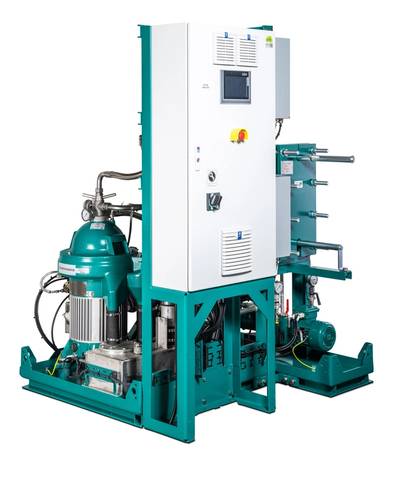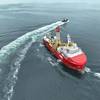GEA Expands Marine Portfolio
GEA is supporting the shipping industry on this path to sustainability with new products to reduce emissions of NOx, SOx, particulate matter and soot, and new biofuel separators and solutions for the treatment of process water in exhaust gas recirculation (EGR).
GEA biofuel separator
By using biofuels such as hydrotreated vegetable oil (HVO) and fatty acid methyl ester (FAME) as an alternative for diesel engines, greenhouse gas and sulphur emissions can be reduced. However, effective fuel treatment is essential to ensure peak performance and avoid costly engine wear. The new GEA biofuel separators are tailored to the specific properties of biofuels and efficiently separate water and impurities. The GEA biofuel separators meet the fuel requirements of ISO 8217:2017 and are versatile. The separators can operate seamlessly with any type of biofuel and ensure compatibility with the evolving landscape of sustainable fuels.
The GEA biofuel separators feature an integrated direct drive that GEA says provides unmatched performance per square meter of space. The service concept contributes to the longevity and reliability of the system.
The GEA separators are equipped with digital connectivity functions. This allows cleaning processes to be initiated and monitored remotely. This enables proactive maintenance and minimizes downtimes.
Technical upgrades for older generations of separators are also offered. It is possible to upgrade older generations such as OTC, OSD and OSE separators to make them compatible with the properties of biofuels.
Solutions for the treatment of EGR process water
Based on the GEA NOx separator concept, GEA offers a complete series of EGR modules for engine outputs of up to 200MW. With the new GEA NOx separator and the GEA bilgEGR solution, GEA is now expanding its portfolio for wash water treatment in exhaust gas recirculation in the marine sector. Together with industry partners, GEA has developed the GEA NOx separator with direct drive to meet strict environmental protection requirements and the needs of ship operators up to 10.000 l/h with a single separator.
The GEA NOx separator does not limit the further development of a combined water treatment system. A combined EGR/OBW (oily bilge water) system, the GEA bilgEGR solution, is a compact skid to minimize the equipment and installation costs associated with the discharge of EGR wastewater and the discharge of bilge water on the vessel. This can be achieved by the correct design and control of the combined system. The arrangement of a combined discharge system is already approved and certified by the DNV class to ensure separate handling of the discharge.
The optional function of a combined EGR/OBW system ensures that EGR wastewater and bilge water are treated separately for discharge into the sea.
GEA bilge separator with heat recovery
The GEA bilge separator has been upgraded with heat recovery function as a standard to ensure our commitments towards sustainability. A built-in plate heat exchanger (PHE) with steam, hot water and electricity options saves up to 80% of the heating energy required to raise the temperature level of the feed water to the separator by transferring heat from the cleaned, heated water to the feed water that was lost in the previous design.
The warm, clean water from the separator flows through a PHE, heats the cold inlet and achieves the heat recovery. Instead of pumping the warm water overboard, the water is used to heat the feed water inlet. Only a small amount of additional heat input is required to heat up the feed water to separation temperature. No hot bilge is discharged overboard.
GEA at SMM
GEA will present the GEA bilge Separator, the GEA marine Separator and future-oriented solutions for industrial marine refrigeration and gas compression at the global marine trade fair SMM in Hamburg from September 3 to 6, 2024 (Hall A 3, Stand 316).














